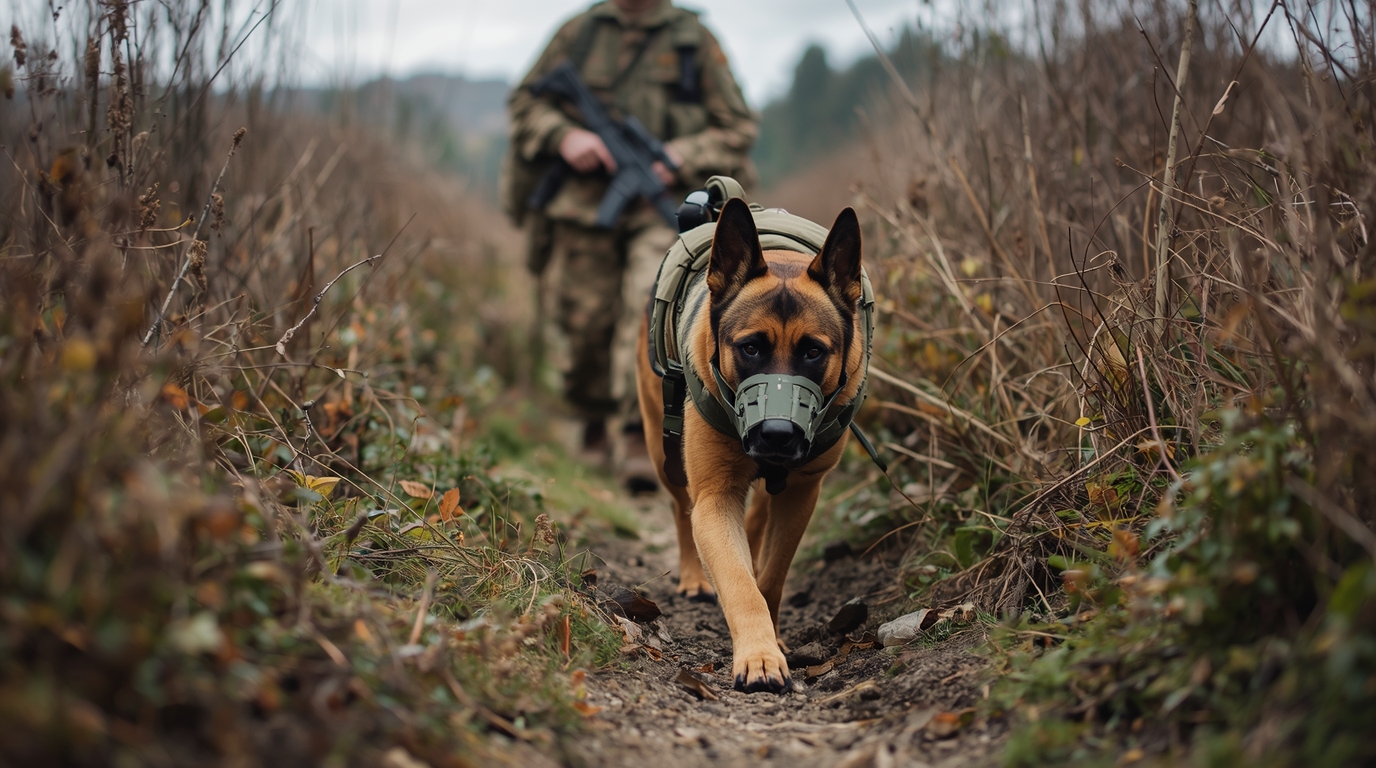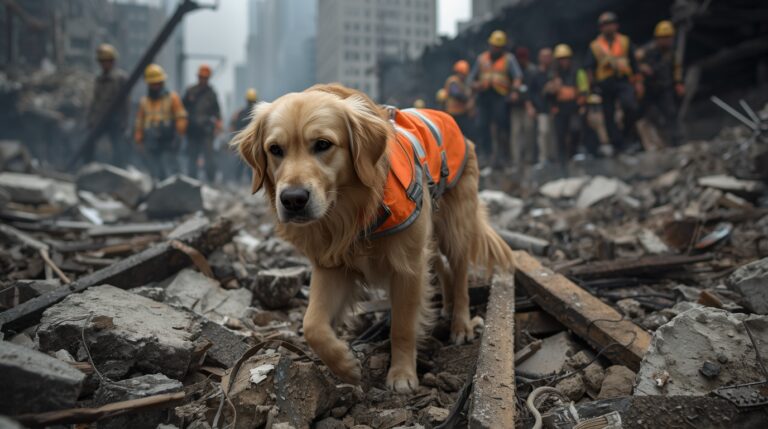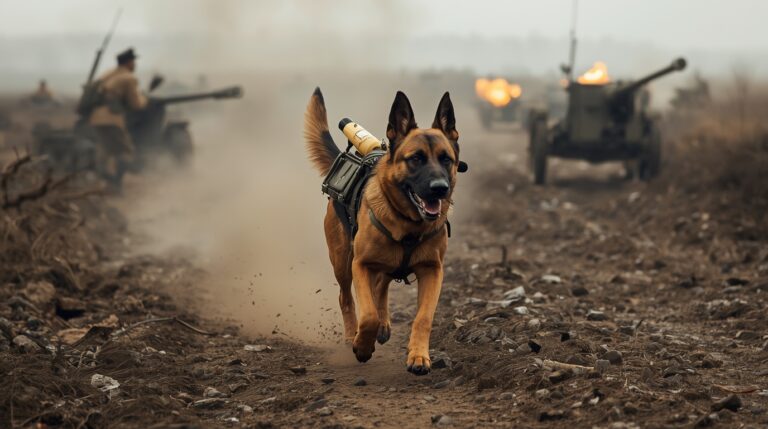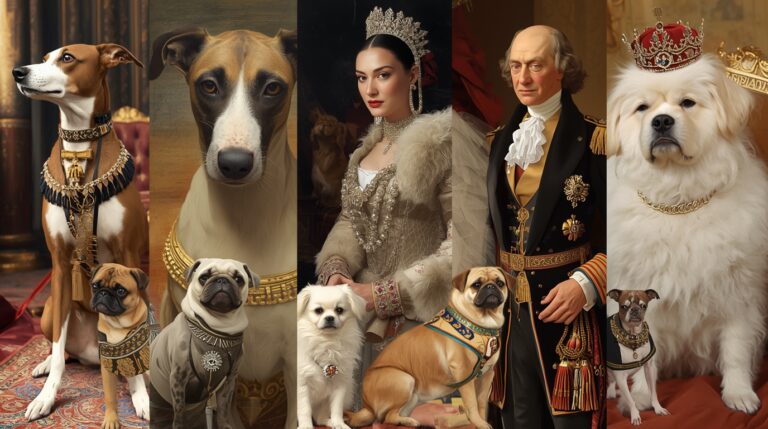Dogs in World War II: Mines, Guards, and Sled Teams

Introduction
During World War II, as mechanized warfare evolved, so did the strategic role of military animals—especially dogs. Unlike their largely ad hoc roles in WWI, dogs in WWII were trained systematically for tactical and logistical functions. They detected land mines, guarded military installations, and even formed sled teams in arctic environments.
This article explores the critical contribution of dogs during WWII across major theaters, examining their deployment as mine detectors, sentries, communication relays, search and rescue units, and transport aides. Through detailed historical examples, breed selection, and specialized training programs, we highlight how these animals became integral assets in military operations between 1939 and 1945.
also read this Dogs in Warfare and Service
Evolution of Canine Warfare from WWI to WWII
After WWI, military planners across nations recognized the proven tactical value of dogs. By the time WWII erupted, dogs were no longer mere companions or mascots—they were trained soldiers.
Major military powers including the United States, Germany, Britain, and the Soviet Union expanded their war dog programs, integrating them into infantry units, engineering battalions, and Arctic divisions.
Strategic Use of Dogs in WWII
Dogs were used in both offensive and defensive roles, including:
- Mine detection
- Sentry and guard duties
- Sled transport
- Messenger relays
- Search and rescue operations
- Anti-tank dog programs (notably by the USSR)
Mine Detection Dogs
The Problem with Land Mines
Land mines were used extensively in WWII, especially in North Africa, Italy, and France. Clearing minefields posed deadly risks for soldiers. Early mine detection equipment was bulky and inefficient, especially in sandy or wooded terrain.
How Dogs Detected Mines
Dogs trained for mine detection learned to:
- Sniff out the scent of explosives or chemical residues
- React passively (usually by sitting or pawing lightly) when they located a mine
- Work in tandem with human engineers for defusing
These dogs saved thousands of lives by identifying mine locations 3x faster than manual detection teams.
Historical Case: The Royal Engineers’ Canine Corps
In the British Army, dogs from the Royal Engineers’ Canine Section were deployed in Normandy after D-Day to clear mines. Using German Shepherds and Labradors, they helped create safe paths through enemy territory.
Breed Selection for Detection
- German Shepherds: Exceptional scenting and obedience
- Belgian Malinois: Agile, intelligent, and strong work ethic
- Labrador Retrievers: Highly trainable with a strong nose for explosives
Guard and Patrol Dogs
Purpose of Sentry Dogs
Guard dogs served as early warning systems at:
- Ammunition depots
- Prisoner-of-war camps
- Military bases
- Airfields and radar stations
They could detect enemy infiltration attempts under cover of darkness and were often deployed with handlers on night patrols.
United States K9 Corps
The U.S. Army’s War Dog Program, established in 1942, trained thousands of dogs as sentry and scout dogs. Known as the “K-9 Corps”, it included more than 10,000 dogs by war’s end.
Key Roles and Functions
- Alerting soldiers of ambushes or snipers
- Guarding supply trains in jungle or desert terrain
- Protecting prisoners and bases from sabotage
Example: Chips the War Dog
Chips, a German Shepherd–Collie–Husky mix, served with the U.S. Army in North Africa, Italy, and France. He once attacked a machine-gun nest, forcing the surrender of enemy soldiers. He earned a Silver Star and a Purple Heart, becoming the most decorated dog of WWII.
Sled Dogs and Arctic Operations
Frozen Theaters of War
In areas like Alaska, Greenland, Siberia, and Scandinavia, traditional vehicles couldn’t function reliably in ice and snow. Sled dogs became essential for transporting:
- Ammunition and supplies
- Communication gear
- Injured personnel
Dogs in the U.S. Army’s Arctic Division
The U.S. Army Quartermaster Corps organized sled dog teams for rescue and supply missions in Alaska and Canada. These dogs were bred for endurance, thick coats, and team cooperation.
Breeds Used in Sled Teams
- Alaskan Malamute
- Siberian Husky
- Greenland Dog
Example: The Greenland Patrol
During the war, U.S. and Danish forces operated a sled-based patrol network across Greenland to monitor German weather stations and U-boat activity. These teams, accompanied by dogs, traveled over 1000 miles per winter season.
Dogs as Messengers and Communication Relays
Just like in WWI, dogs in WWII carried written messages, radio wire, and even small equipment between units under fire or in difficult terrain.
In the Pacific Theater, dogs were often more reliable than radio due to jungle interference. Trained Dobermans and German Shepherds from the U.S. Marine Corps War Dog Platoons relayed information swiftly and without error.
Training Regimens
- Route memorization up to 5 km
- Noise and explosion desensitization
- Handler-specific loyalty protocols
Search and Rescue Dogs
After bombings in cities like London, Berlin, and Warsaw, dogs were used to:
- Find survivors trapped under rubble
- Alert medics to the wounded
- Help in recovery of the deceased
Civilian Search Units
Organizations like Britain’s Civil Defence Service employed Border Collies and Terriers to locate civilians buried in the wreckage after German air raids.
Success Rates
Search and rescue dogs could locate buried survivors up to 24 hours faster than human teams in urban rubble, dramatically increasing survival chances.
Anti-Tank Dogs: The Soviet Experiment
The Controversial Use
The Soviet Red Army deployed dogs as mobile anti-tank mines. These dogs were trained to:
- Run underneath enemy tanks
- Detonate a mine strapped to their back via contact triggers
Ethical and Tactical Challenges
- Dogs were often confused by Soviet vs. German tanks
- Many refused to run under tanks or fled
- High mortality rate, both canine and human
Despite controversy, it remains a significant example of how animals were weaponized.
Dogs in Psychological Warfare and Morale
Companionship for Troops
Dogs served as emotional anchors for soldiers. Whether in foxholes or camps, dogs offered:
- Psychological relief from war stress
- A sense of routine and normalcy
- Companionship in isolated posts
Mascots and Symbolism
Many units adopted dogs as unofficial mascots, dressing them in unit patches or naming them after battles or leaders.
Example: The Australian 2/1st Battalion had a Terrier named Gunner, who could hear Japanese aircraft minutes before radar detection.
Global Canine Contributions
United Kingdom
- Utilized dogs in RAF airfields, coastal patrols, and bomb disposal
- Established the War Dogs Training School in Surrey
Germany
- Had the most structured program; used 30,000+ dogs
- Emphasized sentry, mine, and medic roles
United States
- Formed the Dogs for Defense initiative in 1942
- Trained dogs at Front Royal, Camp Rimini, and other bases
Soviet Union
- Utilized dogs across mine, messenger, and anti-tank roles
- Raised moral questions due to suicide missions
Post-War Fate of Military Dogs
Many war dogs were:
- Returned to civilian life after retraining
- Adopted by handlers or military families
- Honored posthumously with medals, statues, or war cemeteries
Medals and Recognition
While most countries did not officially award dogs, several received unofficial decorations, including:
- Dickin Medal (UK) for animal bravery
- Purple Heart (USA) in rare instances
- War Medals from local governments or military units
Dogs in Propaganda and National Identity
War posters and film reels depicted dogs as:
- Symbols of loyalty
- Fighters alongside men
- Innocent beings caught in human conflict
They were featured in newspapers, children’s books, and wartime propaganda to strengthen the emotional connection between home and the front.
Training Programs Around the World
Training lasted 8 to 12 weeks, depending on role:
- Guard dogs focused on scent identification and aggression control
- Mine dogs practiced scent discrimination of metal vs. chemical signatures
- Sled dogs were conditioned for teamwork and cold endurance
Challenges Faced by Dogs in WWII
- Exposure to extreme climates
- High casualty rates in frontline roles
- Poor treatment in some Soviet and Axis programs
- Lack of medical care and combat trauma
Legacy of Dogs in WWII
WWII dogs laid the foundation for today’s military working dog units, serving in:
- NATO forces
- Border patrols
- Counter-IED units in Afghanistan and Iraq
Their legacy is commemorated through:
- Statues (e.g., Animals in War Memorial, London)
- Documentaries and films
- Ongoing K9 Veterans Day observances
Conclusion
Dogs in World War II were not passive mascots or trench pets—they were trained warriors. From detecting deadly mines, guarding vital installations, and hauling sleds across frozen tundra, to rescuing civilians and sacrificing themselves in battle, these animals played indispensable roles.
Their presence on the battlefield was a powerful reminder of the enduring bond between humans and animals, forged not just in peace, but in the most violent episodes of history.




